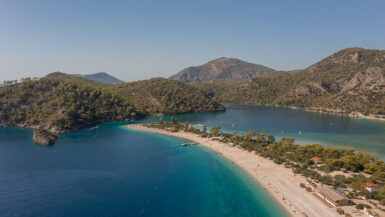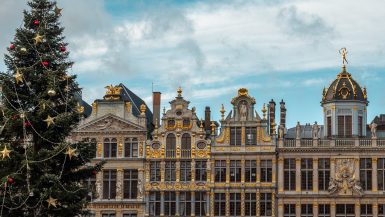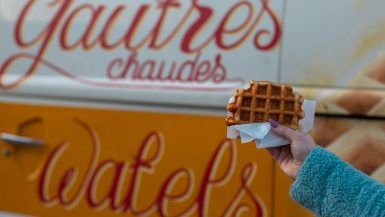In 2016 Madagascar had 293 thousands visitors, one year later 366 thousands and in 2018 around half a million. It may seems quite a few but is it really? In comparing tiny Vatican is being stormed every year by 6 million people! If you’re wondering how to get there, where to stay and how you can organise everything by yourself – we’re here to help. We have struggled big time in finding reliable information about Madagascar. We’ve decided to gather all knowledge and experience we have to create practical travel guide about Madagascar. You can discover this exotic Island down below!
When to go to Madagascar?
Choice have to be made on a base of style of traveling, a goal and region which you want to visit. We’ll try to generalise on it:
- Dry season – period between June and October can be described as a dry season which in fact is Malagasy winter. Temperatures aren’t that high, humidity is lower and it’s not that stuffy. Rain is almost non existing so there is no issues with travelling and access to some national parks or parts of them. You have to be aware activity of wild life is the lowest and some animals hibernate over winter. September is the best for watching birds, whale season is between beginning of July and middle of September. July and August are high season, the most tourists and prices are at peak.
- Rain season – From January to March there is a summer in Madagascar. Rain is plentiful, it’s hot and stuffy. There is a high chance of travel issues, roads are flooded and many national parks unreachable or closed ( e.g. canyon in Ankarafantsika isn’t reachable. If you are lucky you might just be able to see it from the top). All animals are the most active, especially reptiles and amphibians. Cyclones strikes very often especially on East coast. During rainy season plague epidemic risk it’s at highest and mosquitos are plentiful. Prices drops and tourists are few.
- Middle season – during April and May as well as November and December there are transition periods. There is much less rain than during rainy season and temperatures are high enough. In April there is still slight risk of cyclones. Both periods are good for watching wildlife. There should be no major issues with travelling and national parks access. Middle season offers more favourable prices.
We have chosen May and we’re very happy with that. We haven’t got any pouring rain during the day, if there was any it was during the night when we stayed in accommodation. We managed to see quite a lot of animals just getting ready for winter. Temperatures were high and prices affordable.
How much time do you need for Madagascar?
We were there 21 days and haven’t seen even half of an Island. 14 days is an absolute minimum as traveling from one place to another is extremely time consuming. Optimum time to travel around whole Island is around 6-8 weeks if traveling by 4×4. If you want to visit Nosy Be Island 7 days is enough. But Island itself and all surrounding are so interesting you can easily spend 14 days there.
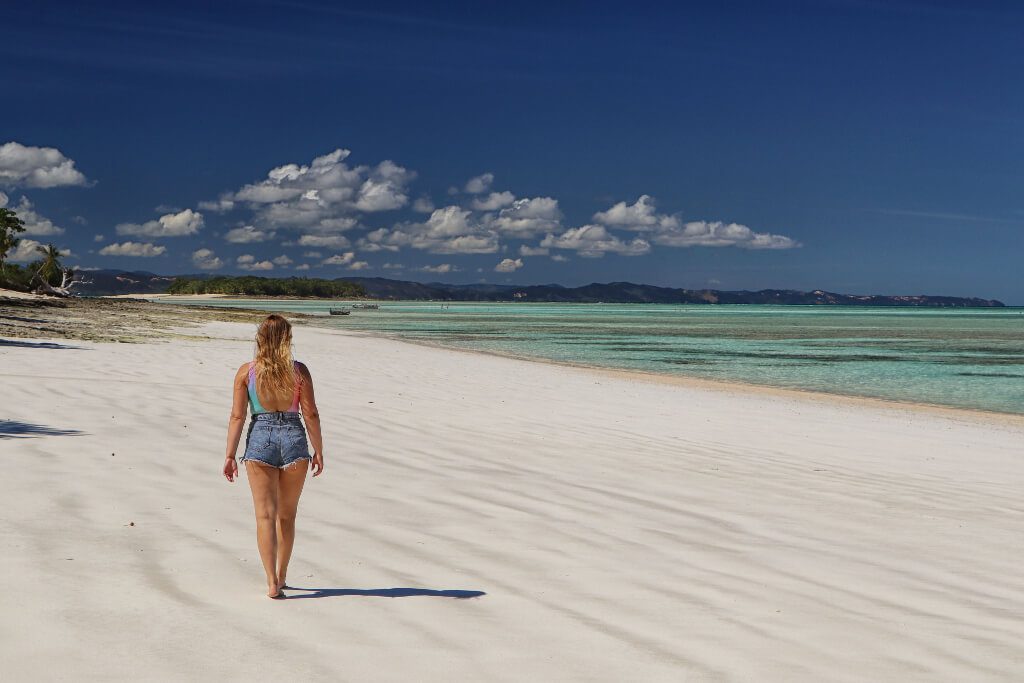
How to get there?
The easiest way to get to Madagascar is fly to the capital Antananarivo, second most popular option would be Nosy Be Island. From our research it looks like flight to Tana is more affordable than Nosy Be but it depends from many factors including some luck. The cheapest flight we came across was around 550 euro p.p. (multicity: Warsaw – Vienna – Tana and Tana – Addis Ababa – Dublin) We snoozed and paid more for this flight.
You can find direct flights from Paris and Marseille, outside of Europe there are direct connections with Mauritius, Reunion, Kenya, Ethiopia, RPA and Seychelles. Majority of flights requires stopover with most of them in Addis Ababa and Nairobi. Direct flights to Nosy Be are from Rome and Milan. It’s the most touristic place in Madagascar and there are chances of charter flight – from Poland Itaka travels offers some.
Direct flight is around 9-11h depending on destination.
The most frequent flights are with: Ethiopian airlines, Air Madagascar, Air Mauritius, Air Austral, Air France and Kenya Airways.
*Practical tip
All retail units in International Terminal doesn’t accept local currency of Ariar! The only accepted one is Euro and some accept USD we also managed to pay by card. If you have some local currency left you can exchange it in front of the airport with money changers. Many guides and taxi drivers gets euro coins as a tip and try to change it for bills. It’s happening in front of terminal buildings so you can change bills for coins. Both sides gaining on this.
Transportation in Madagascar
Plane – There is quite a few local airports on the Island so in theory it supposed to be great transportation mean. We’ve researched a lot and we do agree all goes in the right direction. Couple of years ago Air Madagascar was a provider of local flights. Flights were very often cancelled, delayed even few days and passengers were kept in the terminal for several hours – all experienced by people we talked to. On the other hand cost at starting point was 250 eur per person for Nosy Be-Antananarivo flight. In 2018 Air Madagascar was restructured and sister company Tsaradia was created. Air Madagascar operates only international flights and Tsaradia is relatively inexpensive national carrier. When we were booking our flight website was in French only but now it’s in English as well – check it out here. Price depends from a tariff. We didn’t think too much and took basic one for 100 eur per person form Nosy Be to Tana (as we said relatively inexpensive, to compare same route by car, local company told us 500-800 eur). Basic tariff included 20kg check in baggage and 5kg (wasn’t checked) hand luggage plus drink and snack isn’t bad for 1h 30 min flight. If you are planning to fly with Tsaradi we do recommend to have time buffer. Our flight was scheduled in the morning but was change to evening time. We were informed much in advance and it didn’t collide with our flight home so no drama for us with Tsaradia Airlines.
You can book Tsaradia flights here.
More opinions about this airlines you can find on TripAdvisor.
Car
–on your own – renting a car on your own in Madagascar it’s not that easy. There isn’t many companies who want to do that and after 3 weeks over there we are not surprised. Roads in Madagascar can hardly be called that. They are in terrible state and instead of enjoying our trip we would stress how to overmaster another 10km of the road. When driving by yourself you can’t really take a nap if you have 10h of driving scheduled during the day. Time is another factor, it would probably take much longer to do it by ourselves (anyway it was long enough). Language barrier is the most important factor. There are places where next gas station is in few hundreds kilometres, the bridge might collapse and there is traffic jam which cause delay for few days or there is a thug gang nearby robbing cars. You won’t know that but your driver will. When car breaks down (it’s highly possible it will happen at some stage) you don’t have to worry about it. Driver will look after it and most likely friend of a friend will be able to drive you to your hotel when car being fixed or replaced. If you really want to do it by yourself (there is a few who managed ) you need 4×4 – stronger engine – better. You shouldn’t drive after sunset – there is no lights and it’s easy to hit someone (roads are main walking tracts for local people) and sometimes you might be an easy target to robbery. Prices are somewhere around 50-80 euro for a day, more days you plan cheaper it’ll be. Prices depends from a season and one litre of petrol is 4 200 Ar.
Car without a driver can be organised by Road Trip Africa or Ramartour.
–with a driver – we were really determined to drive by ourselves but after analysing all pros and cons it made more sense to go for this option. It wasn’t trouble free for us. We’ve planned all by email with Tsu, we were picked up by Rivo and next day we found out our driver will be Jao (all with different cars). First 2 from unfortunate personal reasons couldn’t do the trip and we were little bit apprehensive when told Jao’s English is very limited. You don’t have to be fluent if there is a strong will and enormous amount of positive attitude and humour. We were on the same page with Jao and not only he was our driver but felt like our good friend. On top of that Jao was a guide, translator and sometimes our guardian angel. Many long evenings with local beer we spent exchanging information about Madgascar, Poland and Ireland. We are completely convinced without Jao we wouldn’t be able to get so deep into Malagsy culture due to language barrier mainly. There was nothing uncomfortable being around somebody new for almost 24/7, from first day we felt like we knew each other for years.
For 11 days we paid 1620 euro. Included in price was a car, petrol, driver fee who was our guide too, entry fees to National Parks and NP guide fees. We were lucky as Jao organised fantastic local guide who spend 4 days with us enriching our knowledge about Madagascar.
Clients are not responsible for a guide accommodation and food. Mostly it works as barter, driver brings clients who pays and he can gets a bed free of charge or for much smaller fee.
Unfortunately on many occasions in high season drivers rooms are dirty and overcrowded. Many times they prefer to sleep in a car or find something in the village or town if you are nearby. In one of our accommodations Jao didn’t get the room ( we were surprised we did get one – it had to be something wrong with a booking as we were treated like intruders not guests ?). We actually offered for him to stay with us but it was no way he would agree to that. In the end he found something nearby. Remember driver doesn’t have to help you in finding accommodation but all of them are always really helpful. It’s a nice touch if you share a water or a snack with your driver. We usually got him a beer in the evening or few beers and when there was opportunity to share a meal we did so. As a rule driver will get portion of rice with sauce and some veggies. It’s very important to remember a driver isn’t your servant and you should pay a proper respect which every person deserves!
Taxi Brousse – long distance vans filled with people and products like jam donuts in your local bakery. Name might be misleading as they have nothing to do with a real taxi because you wait until it’s completely full to tart your journey. Biggest advantage is the price, you will pay 4000Ar (1 eur!) between Diego Suarez and Joffreville. When it comes to disadvantages… you never know when it actually going to leave and how long it will take. In one village they will have to install bunches of Pineapples on the roof in another one boxes of tomatoes or cages with live animals. Route from Antannanarivo to Diego Suarez in the North will take approximately 24h.
Taxi Be – most likely you won’t need this one but it’s easy to mix it up with taxi brousse. What is the difference? Taxi be is a town transportation which only operates around larger towns and suburbs when taxi brousse operates on long distance routes
Tuk Tuk – good option especially on short distances in towns. Fee works around 1000Ar per person for 3km. Tuk Tuk same as taxi brousse are super crowded 6 people for one vehicle is Malagasy norm. Hard to say about comfort and if it’s possible to get one just for yourself.
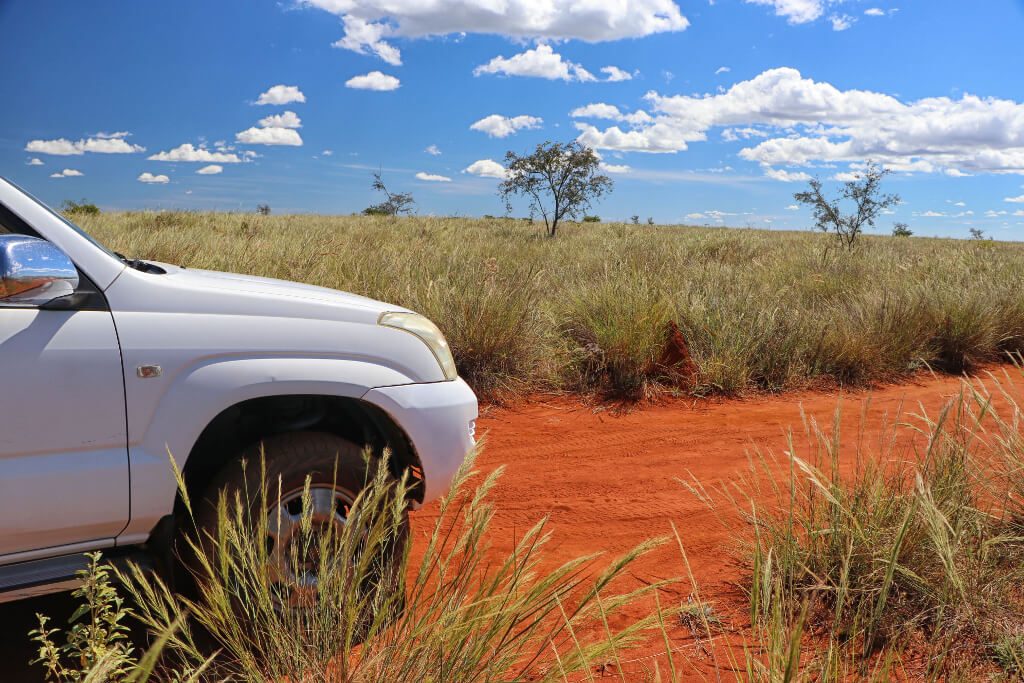
How to plan a trip to Madagascar?
Planning trip to Madagascar isn’t the easiest one but at the same time doesn’t require any extreme abilities. We have gone thru the process and can give some tips. If you want to go around the Island and planning to rent a car you have to have minimum 2 weeks on hand to make it work. Traveling by local transport will be ideal for people who want to spend 3-4 weeks at least. The quality of roads in Madagascar is truly tragic and the worst are national roads. Primary roads called route communale are very often in better shape than national ones. Driving 250 km in Malagasy reality takes 7.5-10 hours depending on the road and driver skills. It’s recommended not to drive during night so amount of time you can spend moving it’s restricted (sunset between 6-7pm). Booking accommodation in advance is challenging as well because not many places have website offers. It can be assumed you can find something on the spot in larger towns, there is always some accommodation around national parks. We have passed our itinerary on Tsu who originally supposed to be our driver and we discussed all details. Drivers and local agencies knows the best about condition of the roads and will be able to tell you what the best plan is. Tsu reserved all accommodation for us despite it wasn’t required. If you like a little bit of freedom you can look for something on the road but some rental agencies required list of accommodation upfront. You have to remember when traveling in high season accommodation around national parks is limited and it might be fully booked. While planning a trip you might look at our itinerary which you can find on a very bottom
Language
In Madagascar there are 2 official languages – Malagasy and French. Knowing French will definitely help but won’t guarantee you’ll be able to connect. Many Malagasy doesn’t speak any French and there are 18 different tribes in Madagascar with different dialects. English is hit-and-miss, in majority of Hotels and restaurants we found someone whose basics allow to communicate. North of Island including Nosy Be is more popular with Italian due to large number of Italian visitors. Language barrier made us appreciate even more company of our driver Joe.
Internet
This was definitely dark horse of the whole trip. Super-fast and efficient, actually worked better than in Dublin, in city centre, supposedly European capitol. In some places we were connecting thru LTE but really good 3G and 4G was almost everywhere. The only place we visited without any reception was Ankarana National Park. Really good internet Malagasy people explain by presence of French business. Unfortunately for majority of local people internet prices are beyond reach. When it comes to Wi-fi there was only resort in Nosy Be where we had a good connection other places have slow one in one area of the hotel or none at all. If you planning to stay connected to the world we recommend sim card.
You can choose between 3 suppliers: Telma, Orange and Airtel. Reception varies by operator and region, in North Orange worked fine, South is ruled by Telma. You can get starter installed in little Kiosk in the airport.
5GB of internet data – 30 euro
Smaller data packages are 10 and 20 euro
*over here we are only speaking about places we have visited in the North. We can’t really say how it looks in other regions.
Currency and card payments
Local currency is Ariar, 1000 Ar is 0.25 cents. We’ve exchanged some money on the airport to have it for first few days. By wave of magic wand we suddenly became a millionaires. For 300 eur you get quite a few notes denomination was quite high so it was no issue with storing it. You should change some of them for a smaller notes which you will have for tips and small purchases.
Cash machines are available in larger towns and we had an access every 2-3 days so you shouldn’t panic and load yourself with cash. If you are traveling South or less visited parts it’s worth to check how often you’ll have an access to cash.
Cities on our route with banks:
- Antananariwo
- Antsohihy
- Ambanja
- Ambilobe
- Diego Suarez
- Helle Ville (Nosy Be)
Our driver said you won’t be able to withdrawn any money with a hat on your head and in one place it only worked when I took my hat off. Not quite sure was it only a coincidence or a real thing but in larger banks there is a guard which will ask you to take it off.
Paying be card is very limited. In capitol – Tana it was the easiest, you can pay in hotels, restaurants, supermarkets. In smaller towns this option is almost non existing. It’s much easier in touristic Nosy Be where every hotel accept card and even payments in euro.
Visa and Passport
Visa applications are given on the airplane and you need an address of a hotel in Madagascar – we only put the name on. To complete the process in the terminal building you have to go thru 3 stages which takes some time and might be pesky.
Visa fee depends on season and you choose 30 or 60 days. You don’t need photo
Prices at the beginning of May (beginning of dry/transition period)
- 30 days – 35 eur, 115 000 Ar or 37 USD
- 60 days – 40 eur, 135 000 Ar or 45 USD
When entering Madagascar you need a passport valid 6 month from the date when you will be leaving the country. You have to present return tickets. Make sure you have the date on it when printing from your mail. We didn’t realise we have no date on our confirmation and it was very close to get our visa cancelled.
You can organise Visa upfront in here.
After our experience we wouldn’t pay upfront. For Malagasy police our one new biometric passport with no stamps was another huge issue when entering Madagascar.
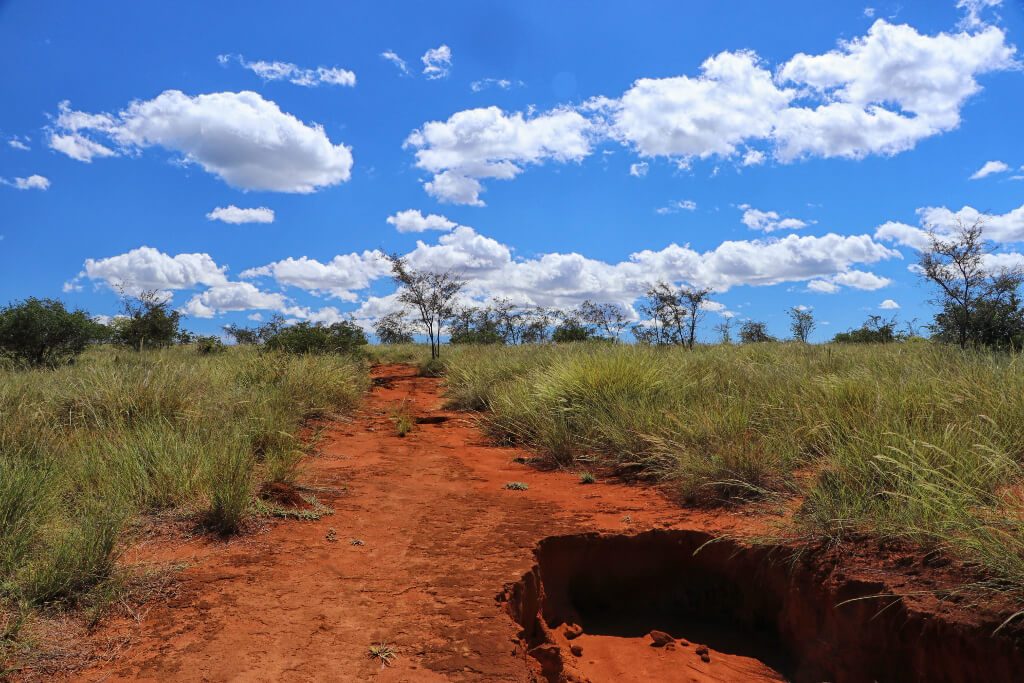
Accommodation
Prices of accommodation starting at around 5 eur per person but much depending on localisation and standard. When traveling in North it’s good to count 10-15eur per person per bungalow/room with a shower. The most expensive is Nosy Be where resorts can be found. All overnight stays were reserved by our driver (expect Nosy Be) prior to discussing budget. We didn’t know where we’re going to sleep and once it was even a real treehouse!
Our accommodation were somewhere between 28-45 eur per room per night. In Nosy Be we took middle range resort and paid 574 eur for 7 nights.
If you are planning to go to Nosy and want to reserve in advance please be quick as room on booking.com were going like fresh croissants in Paris Caffe. It looks like there is small amount of rooms on online sales as we reserved one of the last ones on internet but it was pretty empty when we actually stayed there. There is also a few hostels if you are travelling on the budget:
- Youth Hostel in Ambondrona near Ambondorna Beach
- Hostel Tamana in Hell Ville
We met Polish traveller who were talking about hostel near Andilana beach unfortunately we don’t know the name.
*Practical tips
You don’t have to take your own mosquito net – all rooms have one even in the cheapest places.
Safe was only available in resort on Nosy Be . The best way to keep your cash is always to have little with you and rest spread in different places. Carrying all the cash might be risky if you get unlucky.
Safety
We’ve heard some crazy stories about safety or rather luck of it before going to Madagascar. We were worried a little bit but it turned out it was exaggerated as we felt quite safe almost everywhere but we always followed few safety rules and common sense.
Safety situation differs from region, social-political situation and sometimes a little bit of luck. You shouldn’t stressed too much upfront just use usual precaution. There are reports of tourist being robed in National Parks or cars being hijacked but it’s not like around every corner someone is lurking on white face with kitchen knife.
Foremost you should avoid wondering around large cities like Diego Suarez and Tana after dark. If you don’t have to do it in smaller towns don’t do it either. Generally speaking cities are least safe. Many people from rural areas flocks into cities looking for a better life but there is nothing really they can do. Lack of job and hunger cause frustration which leads to difficult situations. We didn’t exposed any valuables. Camera and all gear was always in a bag, we left jewellery and watches at home.
Before traveling try to search any news about area you are planning to go to. Before our trip there was some political unrest in Morondava region which wasn’t luckily on our itinerary.
Vaccinations and diseases
The only mandatory vaccination when entering Madagascar is yellow fever and only if you spent more than 12h in country of high risk.
You should be aware of this especially if you stopping in Ethiopia for over 12h. There is a body temperature check at the airport. All vaccination should be listed in your yellow vaccine book.
List of recommended vaccinations for Madagascar:
- Hepatitis A and B
- Typhoid
- Tetanus, diphtheria, polio
- Rabies
It’s worth to check your measles vaccine as it appears form time to time in Madagascar.
You should start the process 2 months in advance to have enough time for boosters etc.
One should remember about malaria prevention. Mosquito nets were in all hotels and BnB we stayed you also have to have strong mosquito repellent – ideally 50% DEET. We had MUGGA and one unit was enough for a week for 2 people. When trekking in national parks make sure you have loose long sleeves (forget about leggings – mosquito will burst in tears from laughing lol they can easily break thru). There is also some tough ones up there where no repellent can spoil their party.
We were planning to take some Malarone pills and take a shock dose if needed but we lost prescription and didn’t take any. The whole situation if we should or shouldn’t take pills was under discussion. In the end we didn’t take any but it’s everyone’s own decision.
We’ve heard a lot about sand fleas which occupies heavenly beaches waiting to bite into your feet. You can use MUGGA or any DEET repellent or even anti flea stuff for animals. In the end we didn’t really use any of those and all safe and intact. But if you would feel there is something not right we suggest to go to hospital (yes in Madagascar in might be 300km away) because consequences might not be pleasant (ATTENTION google images can be drastic). You can try to deal with it by yourself – get it out and disinfect – if you’re tough enough. You can also use some surfing boots or something similar to walk on the sand. Again our experience was all positive but don’t take it for granted.
From time to time Madagascar have an outbreak of plague epidemic. The last big one was in 2017. Endemic plague usually appears in mountains during rainy season. There is 2 types of plague: pneumonic which transfer thru droplets and bubonic or septisemic being transfers by animals (rats or fleas for example). When you’re traveling when there are cases reported you have to be very careful. You should avoid crowded places and public transport means as well as stay away from animals. Rigoristic hygiene is a key and repellent use is a must.
You should also be aware swimming pools are not up to European standards, cleaning and water rotation won’t be up to scratch.
Flying drone in Madagascar
Flying a drone ANYWHERE in Madagascar requires authorisation from Civil Aviation Authority otherwise is illegal. As you can image getting a permit is quite difficult and we don’t know how many people were able to do it if any. You should start from filling the form here giving information like serial number of your drone and exact planned route of flying. We guess you need every route to be authorised and planning all of that when abroad would be extremely challenging. Whole process takes a lot of time. You can try to get into the office when already there but again if you want to make it quick you most likely have some spare cash for bribes and know how to do it. We just decided to fly without permit. We tried to avoid crowded places , cities, nearby police checkpoints and not in National Parks. Again we don’t advise to do so it could get much more expensive if you get caught.
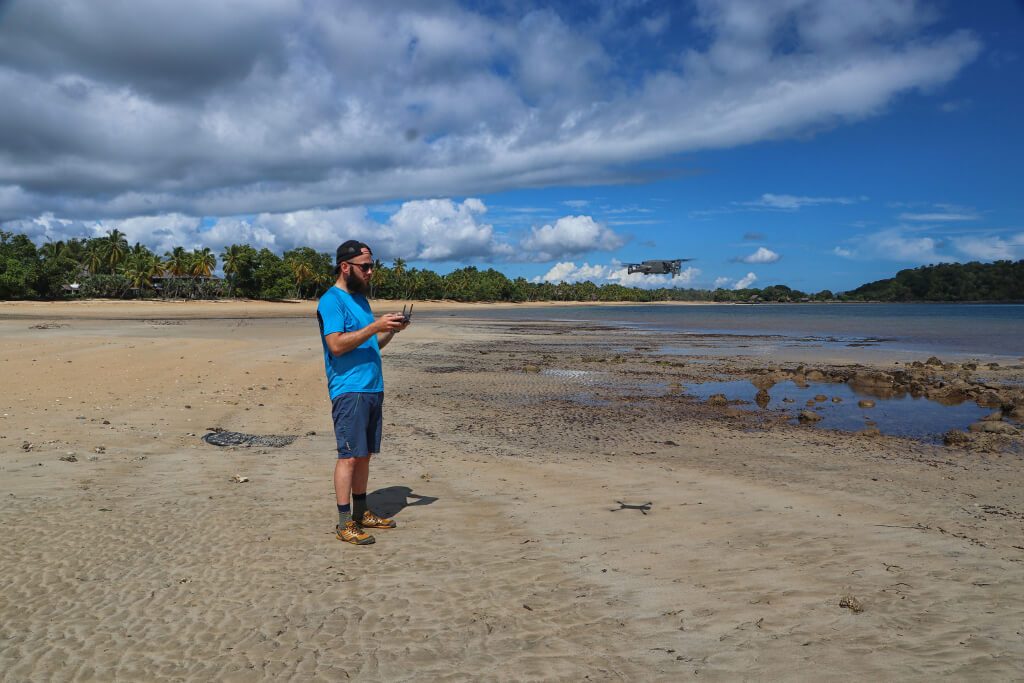
First Aid Kit
Definitely you should take something against diarrhoea and probiotics. Cream for bites and something for small wounds. Calcium and anti-allergic stuff might help with allergies (sun allergy especially). Due to high temperatures take some electrolytes. Sun cream and something to treat burns.
Fady
There are 18 tribes in Madagascar and every each has their own Fady. Fady is nothing else than taboo, collection of rules and customs which one has to follow. Usually foux pas made by tourist are being forgiven but nonetheless it’s worth to be aware of some. As you can image due to large number of tribes there is a whole lot of different Fady. One which is widely spread for example is a ban on pointing with your finger on tombs. One of our guides used to point on them with clenched fist. In Antananarivo eating goats meat is Fady. No-one really could explain why but you just can’t and that’s it. It’s a super interesting topic which you can write separate post about. Wencourage everyone traveling in Madagascar to seek more information on the topic.
Rules and general advice
It’s really annoying when western people, European, American even Asian goes to what they would describe as undeveloped countries and act like undeveloped people. When going to a poor country with significantly different culture doesn’t give a right to anybody to disregard it and act like you own the place.
Respect and dignity of another human being is the fundamental part of traveling it’s not a trip to a zoo. We’ve learnt quick Africa is far different from an Asia where people happily pose to pictures and smiles when see a camera. In Madagascar it’s not always appreciated. It’s a good practice to approach someone first and ask, in most cases gives little gift in exchange. We were advised to buy a box of grey soap for gifts. Of course communication might be difficult due to language barrier but sometimes is as easy as pointing on a camera and handing little gift.
When travelling by car you can encounter groups of kids by the road. Many of them unfortunately screams ‘give me money’ or ‘vazaha’ /va-za/ which means ‘white person’ but some just asks for plastic bottles.
Plastic is a valuable stuff you can use it to transport water or milk, store honey or pickles. After consuming water store bottles in a car as sooner or later you will be able to give it away.
When traveling around Island you should refrain of giving money away to beggars. Maybe older ones yes but definitely not to young children! It only harms those kids, teach them idleness, stop them from going to school and in the long term doesn’t help boosting local economy. Giving small gifts especially for services provided is much better option. Of course when we say small we mean a bar of soap not your swiss watch. Also tipping for services is a nice touch. We really valued people there trying really hard to make something and earn money for carrying your bag or repairing roads. Money should be gratification for service or a product at this case you can even give a little more the asking price.
Food
We were convinced one of the poorest countries in the world won’t have much to offer when it comes to cuisine. It was a nice surprise to find out how wrong we were. Malagasy cuisine is relatively diverse and interesting despite locals in rural areas eat mainly rice with vegetables. Singularity of Malagasy cuisine is deeply connected with history and different influences of Asian cuisine (Indonesian, Malaysian, Hindu) west African and French cuisine. Sound like odd mix but it works pretty well.
Main source of carbohydrates and base of most dishes is rice. Vegetables in a form of stir fries, stews and curry follows on the plate. Equivalent of Beef on the Island is Zebu which originates from India (yes, very same as saint cows). Dishes from Zebu meat are popular in restaurants but very often a luxury for rural people. Chickens are different to industrial broilers, small, thin with firmer flesh but super delicious which makes them appear often on the menu. Seafood and fish is popular in coastal areas and sweet water fish is often served inland (looking at the state of some water reservoirs we tried to avoid).
Some traditional dishes:
- Kobu /cu-ba/ – dessert popular in the middle of the country especially around Morondava. You can see 2 versions of it. More popular consist of sugar, grounded peanuts and rice flour wrapped in banana leaves and cooked in it. Other type is Kobu Akondro which includes banana puree.
- Ranovola – water which is left after cooking rice actually searing after burnt on the bottom. Taste a little bit like grain coffee.
- Ravitoto – dish from squashed cassava leaves which taste a little bit like spinach. Ravitoto is slightly bitter and often served with pieces of meat but the base is vegetarian.
- Romazava – Thin beef stew ore beef soup
- Lasary – pickled vegetables in many different variations. We had most of them from tomatoes which was a bit like red salsa or one form cabbage and carrot with curry powder.
- Sakay – spicy paste from chillies, ginger, garlic and lime juice. There is different type of chillies used so it differs in colour and level of spice. It’s served as a condiments to almost every dish and we couldn’t do without it.
- Mokary – little rice pancakes eaten for breakfast – super tasty
- Bok bok – little donuts fried and sold as a street food
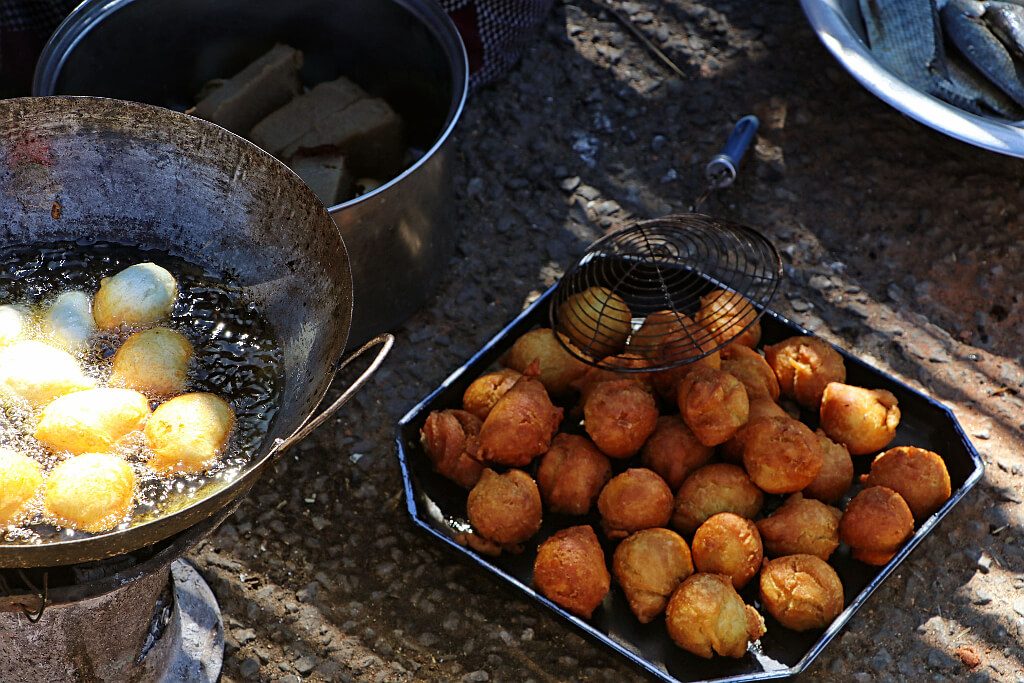
Tips
There is no obligation to tip as such but it’s recommended for services. As we said respect is a key and leaving 1000 Ar should be a starting point. In restaurants 5-10% is highly appreciated.
Useful words
Malagasy people are not really used to foreigners talking itheir language and it makes them really proud when one puts the effort and knows a few words. Few little phrases breaks the ice really quick and we encourage everyone to learn few words
Salama – good morning
Veloma – goodbye
Misaotra- thank you
Azafady- I’m sorry
Vazaha /va-za/- white – not really useful but worth knowing what names people call you as.
Fanafody – medicines (it’s also a sign to look for when in need of pharmacy)
Hotely- small, local restaurant
Tsy mila- I don’t want
Tsy misy- I don’t have
Tsingy- rock formations e.g. tsingy rouge
Arranged rum – maybe it’s not a word in Malagasy language, but it’s very useful. Basically it’s infused, local rum.
Prices
Currency converter: 1 euro is around 4100 Ar (you can check current currency conversion online)
Car rental– between 50 and 120 euro per day, depending on whether the price already includes fuel and the driver. It’s a good practice to give the driver tip or small gift. Gasoline price: around 4200 Ar per litre (around 1.20 euro).
Internal flights- prices start around 80-100 euro one way per person. Price depends on route and chosen tariff.
Examples of local transport prices:
- Taxi brusse from Diego Suarez to Joffreville – 4000 Ar
- Tuk tuk- 1000 Ar/person/3km
- Taxi in Nosy Be- 15 euro/40 km
- Taxi from Tana airport to Tana city centre – around 20 euro
- Speed boat transfer from Ankify to Hell Ville – 15 000 Ar/person. Porters who helps with carrying luggage will expect tip – > 4000- 5000 Ar is a satisfying tip. It’s hard to tell you have any choice – they literally rip your bag off your hands…
National parks tickets:
- 45 000 Ar per person – ‘Parc Natures’
- 55 000 Ar per person – ‘Parcs Phares’
- 65 000 Ar per person – ‘Parcs Exceptionels’ (special parks)
You need to pay extra for guide, it’s not allowed to visit park on your own. Guide fee depends on what route you choose and how many hours guide will spend with you, it’s between 30 000 – 70 000 Ar per day (price may depends on number of people entering with guide). It’s also a good practice to leave tip or small gift, recommended tip is 20 000 Ar per day if you’re satisfied with guide service.
Entry fees to places, which are not a national parks (e.g. nature reserve) like Tsingy Rouge, cascade waterfall in Nosy Be or Mount Passot – fee is 10 000 Ar per person. Half of this amount is allocated to support local communities.
Emerald Sea cruise – 60 000 Ar per person plus guide fee, we paid our guide 70 000 Ar for this trip, but in our opinion guide isn’t necessary (it’s good opportunity to support locals by spending money). Lunch and drinks are included. Massage price on the island – 30 000 Ar
Cocoa plantation entry fee – 10 000 Ar per person (we visited plantation near Ambanja), visit takes around 30 minutes
Rova Palace in Tana – 20 000 Ar per person plus guide fee
Prices in Nosy Be – prices may depends on number of people and tour operator:
- Nosy Iranja cruise – 50-90 euro/person, lunch included
- Quad rental – 175 000 Ar (smaller engine) or 195 000 Ar (bigger engine) for double, fuel is charged extra (approximately 40 000 – 50 000 Ar for day trip)
- Quad excursion with guide – 110 euro for double quad/half day trip or 170 euro/full day trip
- Massage in hotel – 50 000 Ar
- Nosy Fanihy cruise – 40-60 euro/person, lunch included
- Nosy Komba and Nosy Tanikely cruise – 65-80 euro/person, lunch included
- Sport fishing in a bay- 100-180 euro, depends on trip duration, picnic included
- Sport fishing- 600 euro for a boat, max. 3 people, picnic included
- Traditional fishing- 30 euro
- Nosy Sakatia cruise- 60-80 euro/person, lunch included
- Hiking in Lokobe reserve- 60-70 euro/person with lunch included. Entry fee to the park (if you wish to organize on your own)- 55 000 Ar/person
*prices in ariary are for a local trips, prices in euro comes from tour operators/hotels (they using euro, because there’s a lot of tourists from Europe)
Souvenirs
- Fridge magnets – 5 000 Ar
- Hand painted canvas – 40 000 Ar
- Wooden handicraft e.g. salt and pepper container – 40 000 Ar
- chocolate – 3 500 – 5 000 Ar in shops, 8 000 – 10 000 Ar in chocolate boutiques (mainly in Tana)
- spices – 5 000 Ar/bag (cocoa plantation, prices may vary in shops and local markets)
- vanilla – 60 000 – 100 000 Ar per bag (different sizes) in cocoa plantation
Food
The discrepancy in the price range is due to the fact that we ate in different places. Usually food was more expensive in national parks and more touristic places, and cheaper on the route and in cities. The location of the restaurant has a big impact on price – in coastal towns fish are cheaper, beef more expensive, inland the opposite. Tomato salads or beer prices in restaurants could be radically different, so treat the following collection only as a suggestion. In addition, it’s worth noting that we were travelling north, which is considered the most expensive region of Madagascar.
- local breakfast on the road – rice pancakes (mokary) and coffee – around 3 000 Ar for 10 pancakes and two coffees (it was breakfast for three people)
- bok bok – 100 Ar per one
- hotel/restaurant breakfast – 6 000 – 8 000 Ar, 10 000 – 21 000 Ar in national parks
- coffee – 2 000- 5 000 Ar
- main course with zebu meat – 8 000 – 20 000 Ar
- brochette (Malagasy ‘kebab’ served as skewer)- 600 Ar per one skewer
- main course with chicken – 10 000 – 20 000 Ar, chicken dishes are usually more expensive than dishes with beef
- local rum in restaurant – 2 000 – 5 500 Ar
- main course with pork- 18 000 – 20 000 Ar. We didn’t find too many places serving pork, it’s because we travelled north and this part of the county is dominated by Islam, that’s why the price range is quite high
- local Malagasy dishes in restaurants – 8 000 – 14 000 Ar
- sea food – 10 000 – 20 000 Ar
- local snacks – caca pigeon – 1 000 – 1 500 Ar
- imported snacks (crisps, nachos)- 5 000 – 7 000 Ar
- pizza – 12 000 – 18 000 Ar
- spaghetti and other pastas – 8 000 – 11 000, we’re aware it’s not too Malagasy, but they have really tasty pasta (and even more tasty tomatoes), so it’s worth to try it!
- fries, potatoes – 3 000 Ar
- tomato salad, green salad, cucumber salad- 3 000 – 6 000 Ar
- Coca Cola in restaurant – small: 2 000 – 3 500 Ar, large: 3 500 – 6 000 Ar
- small Coca Cola in shop- 1 500 Ar
- large THB beer in restaurant – 4 000 – 7 000 Ar
- small beer in shop- 2 600 Ar (in many places difference between restaurant and shop was minor)
- large water in shop- 1 800 Ar,
- water in restaurant- small: 2 000 Ar, large: 4 000 Ar
- dinner in restaurant/hotel restaurant in Nosy Be – main course prices start around 20 000 – 25 000 Ar and reach around 70 000 Ar, side dishes are often charged extra
- large THB beer in hotel in Nosy Be- 10 000 Ar
Depending on location we used to pay for dinner for 2 with alcoholic beverages around 50 000- 100 000 Ar. Lowest prices were in local restaurants where we used to stop while traveling, huge portions and super tasty food. The most expensive in National Parks in Parks restaurants or Hotel restaurants. Dinner for one person usually around 30 000 – 40 000 Ar (without drinks)
Accommodation (prices below were actual in May 2019 which isn’t high season, it may be more expensive in high season)
- Gregoire Hotel (Tana) – 22 euro
- Blue Vanga Lodge (Ankarafantsika) – 35 euro
- La Paradisier (Antsohihy) – 31 euro
- Hermes Hotel (Ambanja) – 31 euro
- Chez Laurent (Ankarana) – 45 euro
- Le relais de la Montaigne d’Ambre (Mount d’Ambre) – 25 euro
- Lakana Hotel (Diego Suarez/Ramena Beach)- 28 euro
- Anjiamarango Beach Resort (Nosy Be)- 82 euro
- Hotel Citizen (Tana) – 87 euro
All prices are for double room for one night.
Travel costs summary
- Plain tickets – 1500 euro
- Internal flights- 240 euro
- Visa – 70 euro
- SIM card (5 GB data) – 30 euro
- Accommodation – 1072 euro
- Car rental, driver, fuel, national parks fees, local guides – 1620 euro (we paid all together to our driver, price was fixed before we arrived and we also had to transfer 200 euro in advance as protection for cancellation)
- Extra activities – 250 euro
- Extra transport (taxis, boats etc.)- 125 euro
- Food- around 840 euro (average 20 euro per day per person, we ate a lot, so it’s ‘full’ option)
- Tips – 250 euro
- Souvenirs – 70 euro
Summary- around 6070 euro/2 people/3 weeks
Please remember that you should also buy insurance before you go, vaccinations may also be an extra cost if you want to do them.
Other Madagascar posts
Our Itinerary
Day I
Afternoon arrival in Madagascar -> transfer to Antananarivo city centre -> quick walk before sunset in Besorety district
We stayed in a hotel located in so called Old Tana. We arrived quite late but wanted to use last hour of daylight. We took a stroll around local area where there was no tourist at all. People seems to be looking at us with a grain of salt. Streets of Besorety are covered with vendors shacks which are illegally erupted. Outside of main market place you can only sell from stalls on a market day which is once per week.
Accommodation: Hotel Gregoire

Day II
Antananarivo -> Ankarafantsika National Park – 310 km of transfer, around 10 hours of driving
Due to perturbation with driver changes we left at 8am not as we planned at 6am. Road was long but tarmac was in quite good condition on this route. First part was hilly with many villages of red laterite houses. You might think driving all day is so boring but with Malagasy views we value it same as a day spent on actual sightseeing. We have stopped by the red river Betsiboka and in the evening we got a chance to see and walk on Kamoro bridge on river Mahajamba designed by Gustav Eiffel. At the moment bridge is out of use for cars there is new bridge just beside erected in 2015. We’ve reached our hotel in Ankarafantsika after dark.
Accommodation: Blue Vanga Lodge
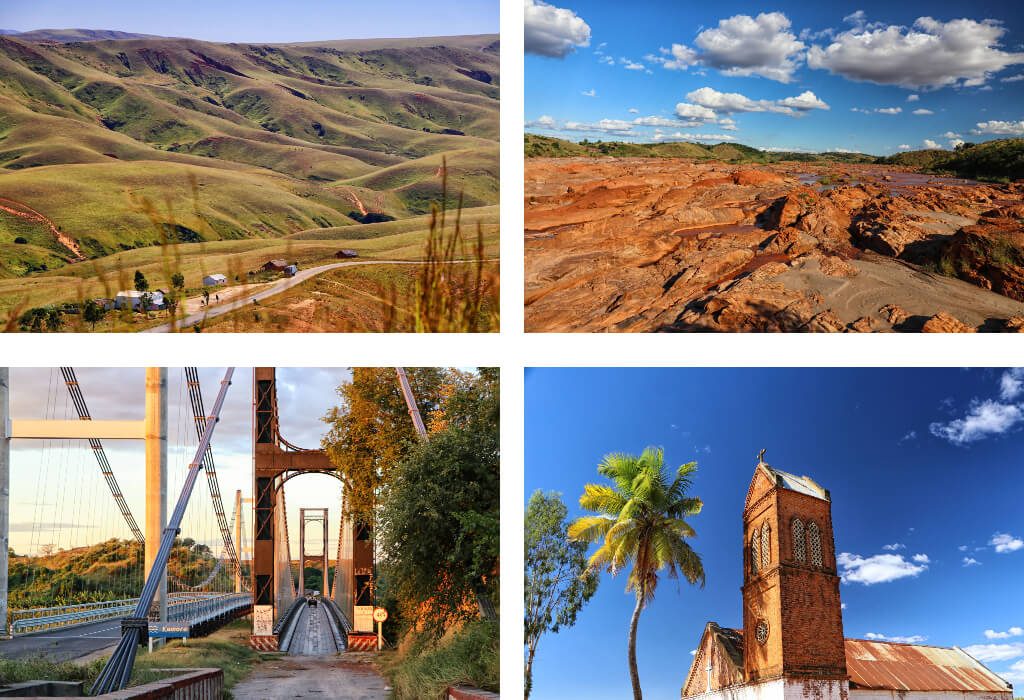
Day III
Trekking in Ankarafantsika – 15km
Trekking was divided into 2 parts. In the morning together with our guide Olga we have visited tropical forest and the we crossed over savannah to red canyon. Our driver picked us up by the canyon and we drove to Park restaurant for lunch. In the afternoon we walked around Ravelobe lake and took a small detour to see Baobabs. More about Ankarafantsika National Park with some tips you can find in here.
Accommodation: Blue Vanga Lodge
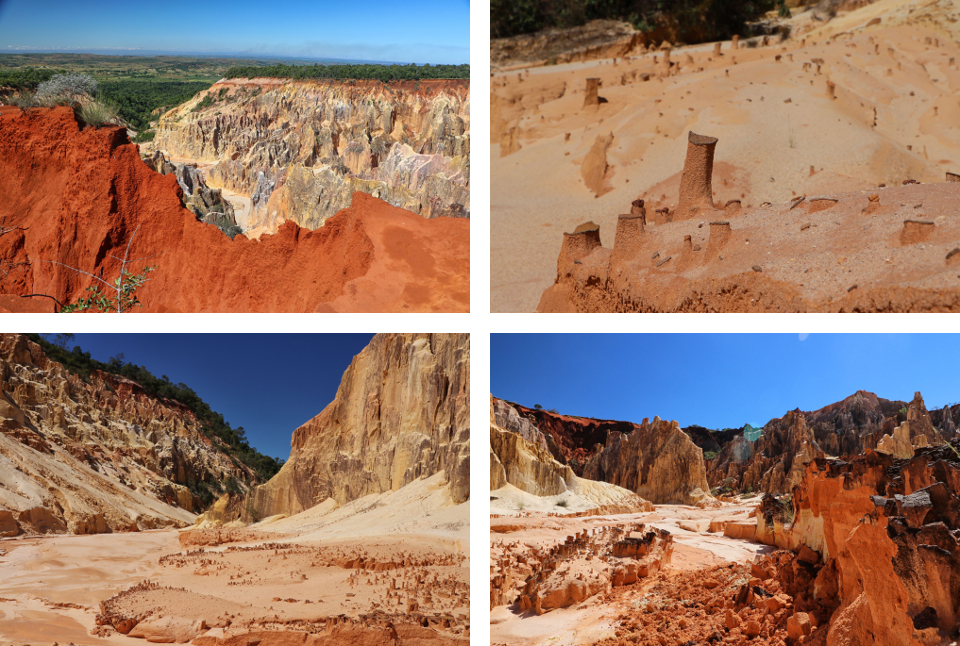
Day IV
Ankarafantsika National Park -> Antsohihy – 317km, around 8h
Next one of days spent in a car. Unfortunately transfer in and out from Ankarafantsika takes forever. Road is getting worse as you travel north so you go slow, long and it’s getting tiring for driver and passengers.
Accommodation: LA Paradisier
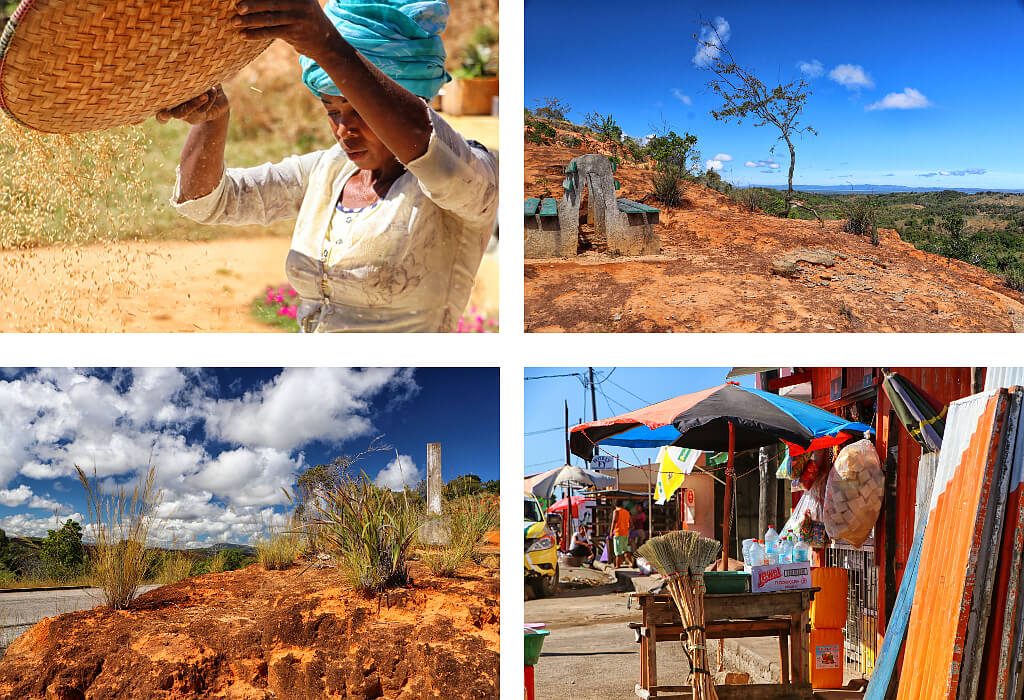
Day V
Antsohihy -> Ambanja – 189km, around 6h
First part of the day was spent in a car the other resting after few hard days on the road.
Accommodation: Hotel Hermes
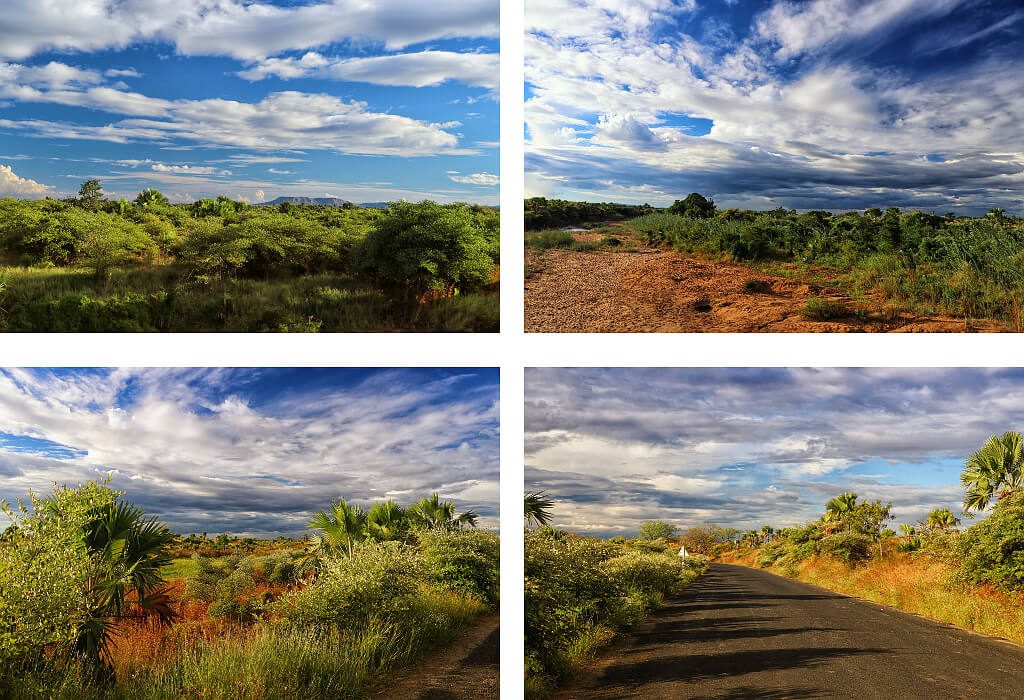
Day VI
Ambanja -> Ankarana National Park – 156km, around 6h
Ambanja surroundings are famous for Vanilla and cocoa plantations. Our drivers convinced us to take a stop and visit one as every opportunity to support local community is ok with us. We stopped shortly after Ambanja and took a short 30min walk. We saw vanilla, cocoa, pepper and tons of other plants. In the end you can shop a little bit. Rest of the day was spent on the road.
Accommodation: Chez Laurent

Day VII
Trekking in Ankarana National Park – 13km
Same as in Ankarafantsika we divided it in 2 parts. In the morning we went to see grey Tsingy, unusual rock formations which have different shapes and colours in different parts of Madagascar. Huge part of the route goes thru tropical forest where we could observe Lemurs and a lot of birds. Lunch was in the form of picnic inside the Park. After lunch we visited huge cave full of bats.
Accommodation: Chez Laurent

Day VIII
Ankarana National Park -> market in Anivorano -> Tsingy Rouge -> Joffreville (Mount d’Ambre National Park) – 140km
Small distance between Ankarana and Joffreville allowed us to plan extra stops on the way. First checkpoint was in Anivorano which is a kind of municipal town, the largest village in this district. We were lucky as it was market place. Antonio our guide took us for a stroll around stalls and our driver was seeking some information about road. Unfortunately we had to skip Le Lac Sacre which is full of crocodiles as the road was impassable. We redirected straight to Tsingy Rouge reserve where you can see red rock formations and enormous red canyon. After reaching Joffreville we decided to take a quick rest and after 6pm when dark we did night walk with Antonio. Many animals gets active at night and it’s a great opportunity to see nocturnal Lemurs or Boa snake.
Accommodation: Le Relais de La Montaigne d’Ambre

Day IX
Mount d’Ambre National Park – around 13km
In the Park we were trekking in what is a remaining of a huge rain forest. Mount d’Ambre is the first Park established in Madagascar. In the forest there is plentiful of animals but also two waterfalls and lake which is a water reservoir for whole area and Diego Suarez town.
Accommodation: Le Relais de La Montaigne d’Ambre

Day X
Mount d’Ambre -> Diego Suarez (Ramena Beach) -> Emerald Sea Cruise – 90km around 2h
We started early to make sure we reach Ramena Beach on time where our cruise was starting. We crossed beautiful Emerald Sea to Suarez Island where we had our lunch. It was whole day excursion and you can find out more about it here.
Accommodation: Lakana Hotel

Day XI
Diego Suarez -> Ankify (transfer to Nosy Be Island) 250km – 8h (many drivers were saying it’s 10h trip but our driver did amazing job ad cut 2h)
It was the hardest day when it comes to transfer. We had 250km and the road it’s as bad as it can gets. Our driver was committed to get us to Ankify as early as possible due to winds and waves which increasing after midday. We left at 4am and we got there around midday. We had to wait a little in the port for a boat to get full.
Accommodation: Anjiamarango Beach Resort
Day XII-XXIII
Rest days in the resort – Nosy Be.
Accommodation: Anjiamarango Beach Resort

Day XIV
Boat trip to Nosy Iranja – Whole day excursion which you can find more about in here.
Accommodation: Anjiamarango Beach Resort

Day XV
Beach Day in Nosy Be
Accommodation: Anjiamarango Beach Resort
Day XVI
Trekking to nearby village and way back along the coastline.
Accommodation: Anjiamarango Beach Resort

Day XVII
Quad trip around Nosy Be Island. We went to nearby ‘Cascades’ which was a little waterfall. We drove up Mont Passot which is the highest point of the Island with jaw dropping view over ocean and mountain lakes.
Accommodation: Anjiamarango Beach Resort

Day XVIII
Air Transit Day
First half of the day we spend by the pool. We could stay in our villa until late afternoon due to low season which was great. In the evening we had a flight to Antananarivo
Accommodation: Hotel Citizen
Day XIX
Andohalo Cathedra -> Rova Palace -> Lake Anosy – around 9km walk
The only full day we spent in Tana – capital of Madagascar. Many people say there is nothing interesting there and poverty and crime thrives. We actually likes Tana really much. It’s a fact there is a lot of homeless, beggars and kids living on the streets in shocking sanitary conditions which really hard to accept. We do our best to travel responsibly be aware of our surroundings and don’t always pretend there is no issues in paradise. We walked up Analamanga hill which is one of 12 sacred hills of Merina tribe. We started sightseeing at Andohalo cathedral actually just from outside due to wedding happening at the time. Just beside there is gigantic Maria sculpture. Next we went to Rova palace which is also called Queen’s Palace. We didn’t have any cash to buy tickets and almost turned around but we were approached by a local guide who said can do a tour and pay our tickets until we find ATM. Surrounding area isn’t the safest one so it’s important to be on guard. While going down the hill we saw tons of people gathering on the market and lots of traditional colourful houses. We ended our trip by lake Anosy with huge sculpture in the middle in memory of soldiers fighting for France during Wold War I.
Accommodation: Hotel Citizen
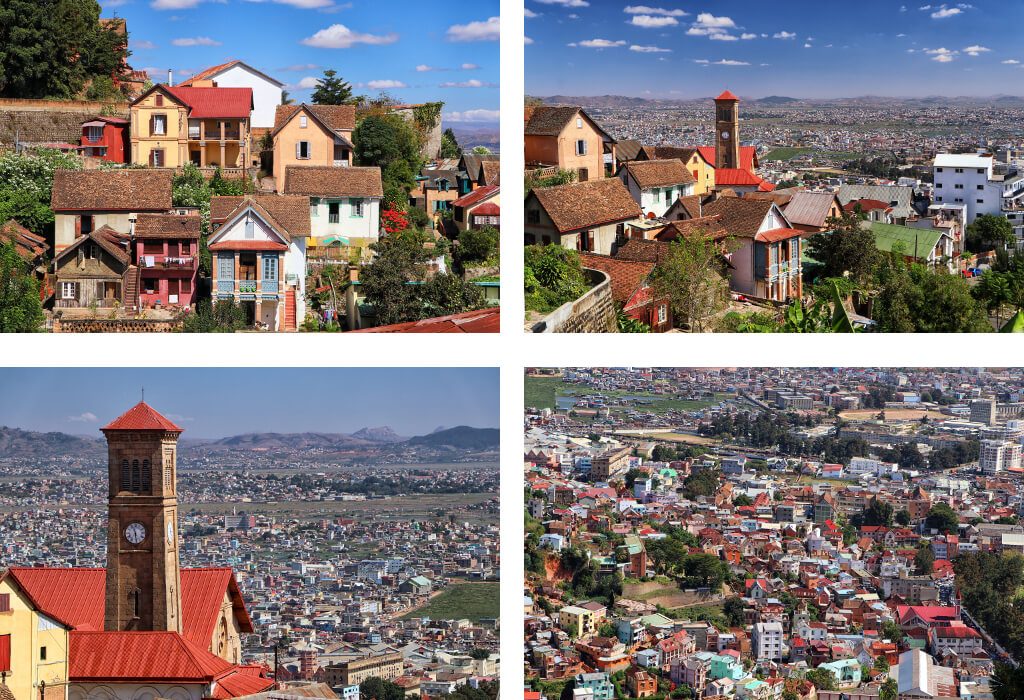
Useful Contacts:
Jao – mrjao4x4@gmail.com –our driver which was our guardian for 2 weeks. His English is not fluent (but he loves to learn new words and phrases) but he was making up with his sense of humour. All in all no issues really with communications.
Tsu-amamih2004@yahoo.fr– Driver who put together our itinerary and booked our accommodation. Tsu has good English and is really helpful. He couldn’t go with us due to personal issues.
Florent –agnayguide@yahoo.fr– guide in Mount d’Ambre, very good English.
John – ph.0344314060- guide in Antananario which helped us by Rova Palace, really good English and great knowledge



